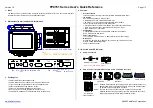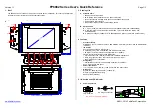
Page 43 of 49
TTI-22 Iss.04– 11/15
Appendix E: Calibrating and Adjusting TTI-22
E.1
Calibrating and Adjusting TTI-22
During calibration the displayed temperature value or resistance value is compared to the display of an
accurate reference thermometer or reference resistor. The deviation from the reference is determined.
During the adjustment the instrument parameters are set in such a way that the deviation from the
reference is as small as possible.
Caution:
The absolute accuracy of the resistance/temperature measurement depends on the calibration and
subsequent adjustment of TTI-22.
• Therefore only let well-trained staff or an authorized institute perform the calibration and
adjustment.
• Record each calibration and adjustment in writing and file these records with care.
The highly stable high-precision resistor VHP 101 from the company VISHAY is installed as internal
reference resistor in TTI-22. Its specifications are as follows:
-
Long-term stability at storage conditions: 5 ppm per year (1 % A.Q.L.)
-
Temperature coefficients of the resistor: < 0.3 ppm/°C (-55 to 125 °C)
The internal reference resistor is barely strained during laboratory use, neither thermally nor electrically
(dissipation loss 100 µW). So these are practically storage conditions.
Caution:
Before the instrument is delivered, the value of the internal reference resistor is determined to four
digits after the decimal point and is stored in the instrument. To ensure the absolute accuracy of
the resistance/temperature measurement, do not change the numerical value of the reference
resistor without prior recalibration.
Determining suitable calibration intervals
If the true value of the reference resistor deviates from the value stored in TTI-22, this will result in a gain
error of the resistance measurement in the used measuring model. If the deviation is 3 ppm, for example,
the additional deviation of the sensors’ resistance display also is 3 ppm.
The resulting systematic deviation of the temperature display approximately stems from the absolute
error of the resistance display divided by 0.1 mOhm/mK (Pt 25) or 0.4 mOhm/mK (Pt 100). Therefore this
systematic deviation of the temperature display depends on the range.
Calculation example:
Measuring instrument:
TTI-22, RRef = approx. 380
Ω
, max. aging per year 5ppm
Sensor:
Pt 100, R1 = 100
Ω
(relates to approx. 0 °C)
Relative deviation of the
resistance display:
5 ppm
Absolute deviation of the
resistance display:
5 ppm * 100
Ω
= 0.5 m
Ω
Resulting deviation of the
temperature display:
0.5 m
Ω
/(0.4 m
Ω
/mK) = 1.25mK (after 1 year)







































